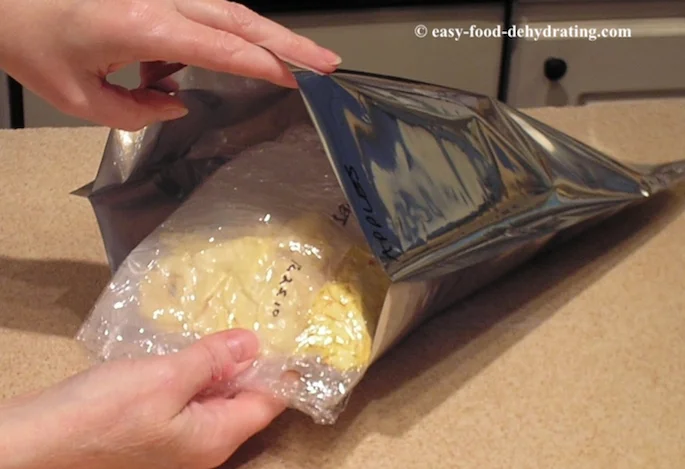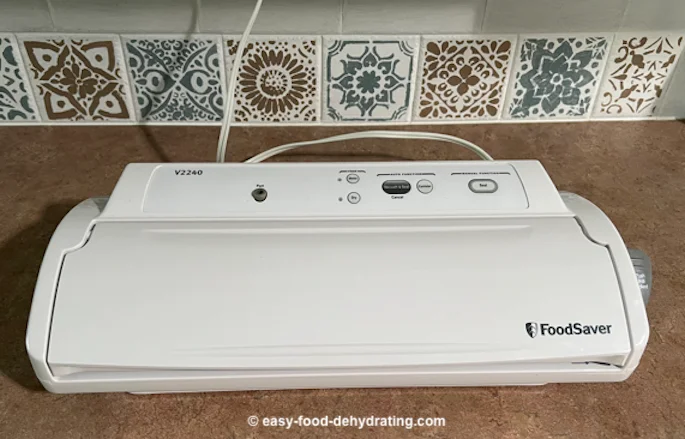- Home
- How to Store Dehydrated Food Safey for Long Term Storage
- Mylar Bags for Dehydrated Food Storage
Use Mylar Bags for
Dehydrated Food Storage
Perfect for Long-Term Food Storage
Use Mylar Bags for
Dehydrated Food Storage
Perfect for
Long-Term Food Storage

Susan Gast | Author and blogger at Bored Boomers, Beesville Books, A New Sober You and Easy Food Dehydrating
Want to know what to use for storing food, long term? Use Mylar bags for dehydrated food storage after you have finished vacuum sealing your dried food.

I use pint- and quart-sized-vacuum bags and make custom-sized bags from rolls.
 Putting vacuum-sealed packages inside Mylar bag
Putting vacuum-sealed packages inside Mylar bagWhen your Mylar bags have been filled and sealed, the final step for long-term food storage is inside plastic-lidded bins, or buckets. Doing all this is for "serious" food preppers.
Frequently Asked Questions:
Mylar bags for food storage?
Mylar bags for food storage?
Yes! Mylar bags are very useful for food storage and extending shelf life. The advantages of using Mylar bags are:
- Airtight seal - Mylar bags provide an impermeable barrier to oxygen and moisture when sealed properly, preventing food spoilage.
- Block light - The reflective properties of Mylar itself block UV light exposure which can degrade nutrients and flavors over time.
- Rodent/insect proof - The tough, tear resistant plastic foil can stop pests from getting in our bags, looking for a snack.
- Lightweight - Thin Mylar takes up little space and doesn't add much weight at all when moving your food bags around.
- Reusable - Mylar bags can be reused - with proper rotation and sealing - as long as they retain integrity (and you have enough "space" at the top of the bag for sealing.
A disadvantage is you can't see what's in
your bags, so remember to write the date and its contents on the bag
after sealing. Or write on the bag while it's laying flat before filling
and sealing, but avoid writing on the top part above where you sealed
it because you'll be cutting off that seal, and you'll have to rewrite
the contents and dates all over again. Ask me how I know.
Mylar bags can hold three or four of our vacuum-sealed bags of dried food. Just don't over-pack the Mylar bags as we want to avoid the bags puncturing each other.
How to seal Mylar bags for food storage?
How to seal Mylar bags for food storage?
Further down the page, I mention that Mylar bags are SEALED ONLY, using the sealing function of the FoodSaver food vacuum-sealer.
We do NOT draw the air out. Why? Because you can't!
Both (inner) sides of the Mylar bags are smooth ... and without the necessary textured bumps on one inner side of the bag (that clear food vacuum-sealer bags have) we wouldn't be able to drawn the air out!
When the Mylar bags are filled with their dried food goodies, we then seal the top of the Mylar bag. Check out this food vacuum sealer instructions page for proper placement of Mylar bags and food-saver bags.
Mylar Bags Give An Extra Layer of Protection
These special bags are made from a polyester film and are very
shiny in appearance. I use them to keep out air, light, moisture, and BUGS!
Mylar bags are very tough and tear-resistant and are ideal for food packaging—they provide an extra layer of protection to our individual food packets.
Mylar Bags at Amazon
Dry-Packs 1-Gallon ShieldPro Mylar Bags
- 10" x 14" Dry-Packs ShieldPro Mylar Bags
- Includes 60x 300cc Oxygen Absorbers (in packs of 20)
- 10" x 14" Genuine Mylar Bags for Long-Term Food Storage
- Pack of 50
- No oxygen absorbers included
* As an Amazon Associate, I earn from qualifying purchases.
The price you pay does not increase.
Who Invented Mylar?
Mylar is a thin, silvery gray polyester film that was first invented in the 1950s by the DuPont chemical company. Now commonly called Mylar, it paved the way for a versatile new form of durable and flexible plastic sheeting.
Today, Mylar polyester film is manufactured by a number of corporations around the world. It continues to be valued for its unique combination of strength, flexibility, and thinness.
Unlike many plastics, Mylar polyester films can be stretched and flexed without tearing or cracking. Mylar also resists punctures which is good to know. Why? Many dried foods are brittle and have sharp points!
Why Use Mylar Bags for Dehydrated Food Storage?
When it comes to storing dried foods, Mylar bags are ideal. They are airtight and moisture-resistant as mentioned above. Keeping your dried foods inside Mylar bags helps keep it fresh and free from mold and other contaminants (bugs!).
I put my filled and sealed Mylar bags inside food storage containers (like lidded bins and buckets), or on a shelf, loose. If you need storage room (and who doesn't?!) check out how to make storage space out of thin air here!
IMPORTANT: Mylar bags offer an extra layer of protection
against the three enemies:
👉 MOISTURE
👉 AIR
👉 LIGHT
If you're looking for a simple and effective way to store your dried foods,
use Mylar bags.
IMPORTANT: Mylar bags offer
an extra layer of protection
against the three enemies:
👉 MOISTURE
👉 AIR
👉 LIGHT
If you're looking for a simple and
effective way to store your
dried foods, use Mylar bags.
Did You Know This?
Mylar Bags are Smooth Inside...
Mylar bags are smooth, both inside and out, unlike food vacuum-sealer bags.
As stated earlier, the reason you can't vacuum these bags, (or at the very least is hard to do), is that both sides of the Mylar bag are smooth and when clamped closed in the food vacuum-sealer, the air cannot be drawn out. But really there's no need to draw the air out.
We simply use the Mylar bags to store our filled vacuum-sealed bags as extra protection.
Here's the reason for the "textured side" in vacuum-sealer bags:
Food vacuum-sealer bags need to have one inner side textured. You need to have a way for the air to be drawn out when vacuum-sealing your packages that are filled with dehydrated food!
PRO TIP:
Understanding Vacuum-Sealer Bags
Look closely at the plastic vacuum bags that the dehydrated food goes into first; you'll notice that one side is smooth and the other side is 'bumpy', for want of a better word.
Vacuum-sealer bags have a bumpy side to enable air removal effectively. Without this texture, air cannot be properly vacuumed out!
Click the images below to view them bigger!
Use a Black Felt-Tipped Marker Pen on Mylar bags

When you've filled your 10-inch x 14-inch Mylar bags, use a black felt-tipped pen to describe the contents of the bags.
Write the date on it too!
Keep reading to see the reasonable number of vacuum-sealed packages that can fit inside one of the bags.
Remember to write on the center of the bag, or at the bottom(!) so that the date and its contents won't get cut off at the top when opening, and resealing.
Place Three or Four (Max!) Packages Inside One Mylar Bag
I can get at least three plastic-wrapped vacuum-packed packages into one bag, sometimes four. Do not over-stuff, though.
If you try to get more in, it makes it harder to seal the bag, plus you risk puncturing the vacuum-sealed packages inside when one pokes against the other. That's the reason why I plastic-wrap the packages after vacuum sealing.
For a 10-inch by 14-inch Mylar bag, don't forget to add a 300cc oxygen absorber for long-term storage, before sealing. Adding an oxygen absorber before sealing is for when you know you won't be going in the bag for a long time.
NOTE: To make sure you understand—we do not vacuum the air out of the Mylar bags for dehydrated food storage, we only use the sealing function on the vacuum-sealer machine; not the air removal function.
The vacuum AND sealing takes place only on the food vacuum-sealer bags, or the food vacuum-sealer rolls. We only draw AIR out of our food vacuum sealer bags that have the oxygen absorber tucked in before vacuuming it! I know I keep going on about it, but I want to make sure it sinks in.
Filled Mylar Bags for Dehydrated Food Storage

Don't forget to check out Amazon for the best prices for Mylar bags—and as you can see in the Amazon ads shown farther up the page, some Mylar bags come complete with a matching number of appropriately sized oxygen absorbers!
Thanks for reading about Mylar bags for dehydrated food storage.
I hope you found the information useful, especially regarding why we do not vacuum the air out of Mylar bags!
Questions? Write to me here.
Don't forget to grab your free Six Simple Steps eBook! It’s packed with tips for dehydrating everything from fruits and veggies to dog treats. Get it here.
Before You Go...
If you like the content, please give me some love by clicking on the 🩷 in the lower right hand corner (on just about all my pages). This signals to me that you find it enjoyable and useful. Thank you so much!




















